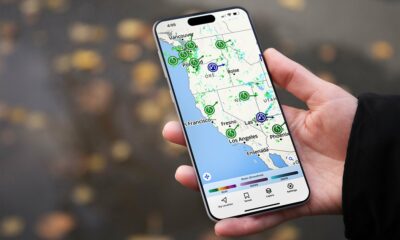SEO
How to Define & Track 7 Key Goals

Online marketing blog, Backlinko.com recently sold to SEMRush for an undisclosed amount.
But we can safely assume it wasn’t cheap.
Between 2013 and 2018, over 4,000 people signed up for the Backlinko.com training program, “SEO that works.”
At $5,964 per subscription, that’s over $23,856,000 in sales.
To join the rank of top B2B publishers like Backlinko, with 468k YouTube subscribers and over 500,000 organic monthly visitors, you can’t wing it.
You need to set detailed content marketing goals.
We’ve got you covered. In this guide, you’ll learn how to define and measure seven essential content marketing goals for B2B publishers:
- Lead Generation.
- Brand Awareness.
- Thought Leadership.
- Organic Share of Voice.
- Roadblocks.
- Educate and Inform.
- User Engagement.
1. Lead Generation
Let’s start with the most important goal, which is tied to money going into your bank account: lead generation.
New prospects may come through whitepaper or ebook downloads, form submissions, or demo calls.
I think we can all agree on why content that engages new prospects is important. You have to keep feeding the machine.
Without new prospects, business stalls or declines.
Determining what type of content supports lead generation can get a little complicated. But stay with me.
Essentially, you need to work backward from your best prospects to find your “high-value pages.”
Defining Lead Gen Goals
This process will not work unless Google Analytics is properly configured with goals in direct relation to how they support your business objectives (and even better if values have been assigned by goal completion type).
The first step is finding what content assists in a user completing one of those predefined goals.
Then make an assessment, is there a trend in the type of content?
Why did this content resonate with your audience?
The answers to these questions will inform your content marketing strategy to get new prospects.
Lastly, work out how many more pages you need to hit your sales goal.
This number is based on the proposed new traffic volume and historical conversion rate.
Measuring Lead Gen
Measuring whether content meets the lead generation goals is easy using Google Analytics.
Here’s how to measure an increase in new prospects:
- Open Google Analytics.
- Click Conversions and Goals.
- Select the Overview report.
- Set Date to the observed time period.
- Set Goals to source/medium.
- View number of goal completions for organic by goal type.
Pro-tip: Take measurement a step further and connect with the sales lead to measure the lift in lead to closed contract.
2. Increase Brand Awareness
Brand awareness is embedding itself into consumer lifestyles and habits (workflows) so that they don’t have to think twice before asking for a Kleenex (facial tissue.)
To do this successfully, a brand must establish trust and consistently create positive associations.
Defining Brand Awareness Goals
There are various types of content that support brand awareness.
You’ll want to select one that is sustainable long-term for a public face of the brand (think CEO or CMO).
Here are a few different types of content to consider.
Storytelling
Authenticity has a powerful influence on public opinion, and it can lead to a big boost in brand awareness.
Beyond the company motto, what is the purpose of your business?
How did it come to be?
Crafting a narrative around your brand humanizes it and gives something real for people to connect with.
Guest blogging
Where else do your users spend time?
You can leverage these sites to get more eyes on your brand.
Keep in mind, the purpose is not to push your company but to offer actually helpful content.
Podcasts
Bring your content to life and connect directly with your audience.
I’m sure you’re picking up on the content trend for brand awareness: authenticity.
A podcast is not to bluntly pitch your company.
It’s an opportunity to educate, entertain and grab the ear of your audience in a way that isn’t possible in print.
Measuring Brand Awareness
 Screenshot from Google Search Console, January 2022
Screenshot from Google Search Console, January 2022Measuring the success of a brand awareness campaign is a little vague.
All the offline conversations between colleagues, feelings of trust, and positive associations are not captured in Google Analytics.
But, we can measure whether content increases brand awareness with intent (as it relates to brand name Google Search volume.)
Here’s how to segment users that already know your brand:
- Open Google Search Console.
- Set Date to the observed time period (12 months).
- Click New and select Query.
- Click the filter drop-down menu (queries containing).
- Select Custom (regex) and Matches regex.
- Use regex that specifies multiple variants of your company name, including misspellings.
3. Thought Leadership
Trust and credibility are two words that constantly come up in conversations about content marketing goals for B2B publishers.
A great way to build credibility with your audience is by creating thought leadership content.
You can do this by sharing unique perspectives, experiences, or resources.
Defining Thought Leadership Goals
The best way to create thought-leading content is by understanding your audience and conveying insights they find valuable.
If you have access to proprietary data, mine that for unique insights and share them with your industry in a deep dive case study and bite-sized graphics.
Or, if you have built a network of professional connections, share their insights that can be conveyed to the masses!
Measuring Thought Leadership
 Screenshot from Google Search Console, January 2022
Screenshot from Google Search Console, January 2022Think of what it means to lead; a good leader has a growing base of users who are excited about the content.
Whether that content is shared through an eNewsletter, YouTube channel, podcast, or social media group you will be able to track subscribers, opens/views, and shares.
Subscriber data should be available within your platform of choice.
For organic channel metrics, look at the search console backlinks report.
Are people linking to your article as a good source of reference?
Here’s how to see which pages on your site have backlinks using Google Search Console:
- Open Google Search Console.
- Under legacy tools and reports select Links.
- Under Top linked pages click More.
Pro-tip: From the search console “top linked pages – externally” report you will have a sheet with every target page, number of incoming links, and number of linking sites.
Review this content to find a trend in the type of articles your audience is interested in seeing more of.
4. Improving Organic Share Of Voice
Identifying your competitors’ strengths and weaknesses is key to setting your brand apart.
One way to “crush the competition” is to improve organic share of voice.
Organic share of voice is a measurement of how visible your site is in organic search, for a set of keywords, compared to your top competitors.
A quick way to get more SERP visibility and clicks is by winning featured snippets.
Featured snippets are pieces of information that display at the top of search results for a search query.
Defining Organic SOV Goals
To find your best-featured snippets opportunities, use your rank tracker of choice and filter to keywords that you rank in positions 2 – 5 for those that have featured snippets.
The most popular keywords should be at the top of your list.
Sort them by traffic volume, from greatest to lowest.
Use this data to find out how well you are doing in terms of visibility on key topics for your business.
If you find any gaps, then you will need to do more competitive research.
Measuring Organic Share Of Voice
 Screenshot from Ahrefs, January 2022
Screenshot from Ahrefs, January 2022Calculating organic share of voice is not straightforward but is possible using tools that compare your search visibility for your target keywords to that of your competitors.
Here’s how to do it using Ahrefs Rank Tracker:
- Open Ahrefs Rank Tracker.
- Paste a list of your main keywords.
- Add your competitors’ domains.
- Click the Competitors report in the overview tab.
- View the visibility metric to see your organic share of voice.
Pro-tip: Do this at the beginning of your content marketing campaign to improve organic SOV and see how your visibility metric improves over time.
5. Reducing Roadblocks
During content strategy sessions, consider why users did not choose your company.
Addressing the reasons why prospects are saying no, enables your company to either highlight that your company does provide the product/service they were looking for – or why the product/service you provide is better than what they think they need.
Defining Organic Share Of Voice Goals
You’ll need to work closely with your sales team.
Team members will need to be notating why people say no.
Or, send a simple survey to lost prospects.
Measuring Reduction In Roadblocks
Measuring whether or not content is intended to reduce roadblocks is easy enough.
Keep in close contact with the sales team.
Is there a reduction in roadblocks, is there an improvement in time to closing or cost of closing?
6. Educational/Informational
Educational or informational content is my personal favorite for B2B publishers because it checks off many of the content marketing goals: Reduce roadblocks, establish trust and credibility and increase new prospects.
I’m a firm believer that people don’t like to be sold to and by sharing knowledge you grow a network of people who value your insights.
So when that topic comes up – they think of you, they share your contact information, they trust your insights.
When a brand provides quality informational content they connect with their audience in an authentic, memorable way.
Defining Educational Goals
Defining educational goals is going to differ depending on the medium through which you’re comfortable sharing information.
You definitely do not need to invest in creating a whole new channel – use the features within the channel that are already working for you.
Because I’m a search engine marketer, I’m going to share an example using Google organic as the medium.
Here’s how to analyze content that is bringing users that indicated they began with a question:
- Open Google Search Console.
- Under Performance select Search results.
- Set Date to the observed time period.
- Click New and select Query.
- Click the filter drop-down menu (queries containing)
- Select Custom (regex) and Matches regex.
- Use regex to show results that indicate a question: what|how|when|why.
Measuring Informational Content
 Screenshot from Google Search Console, January 2022
Screenshot from Google Search Console, January 2022Measuring the success of informational content is a bit fuzzy because education is not necessarily a linear process.
Users view information based on what they’re doing at the time and what they want to read, not how you draw it out in storyboards.
Consider a few metrics: page rank and traffic volume for the queries that indicate a question.
In order for an educational article to be helpful, your audience has to know about it, hence page rank and traffic volume.
If users like it, they are likely to engage with the content and return for more.
More on increasing user engagement in the next section.
7. Increase User Engagement
Step into your audience’s shoes.
There is so much content out there, it can be tough to get their attention.
You have to make sure that the content you are producing is the content that they want to read and that it delivers consistently.
Users who spend time reading your content are telling your team something really important.
They are saying that they value this content and that it is worthy of their time.
Defining User Engagement Goals
Users who engage with your content are more likely to recommend your brand to others, renew their subscription or upgrade.
To define user engagement goals you need to find your top-performing pages for this metric and analyze why.
Measuring User Engagement
User engagement is best measured using Google Analytics 4.
 Screenshot from Google Analytics 4, January 2022
Screenshot from Google Analytics 4, January 2022Here’s how to analyze content that your users engage with the most:
- Open GA4.
- Under Engagement Pages and screens report.
- Set Date to the observed time period.
- Filter to organic users.
- View the table by unique user scrolls.
Note: Unique user scrolls, average engagement time, or a specific event depending on what metric you use to measure engagement.
Final Thoughts
B2B consumers are tech-savvy.
They’re checking multiple pieces of content across several sites and cross-referencing with friends, colleagues and within professional networking groups.
Don’t fall into the trap of a “slick trick” that oversimplifies content marketing.
When done correctly, the content will position your company to answer their questions, nurture their opinion of you, and ultimately convert them into loyal followers/customers.
More resources:
Featured Image: Alphavector/Shutterstock













You must be logged in to post a comment Login